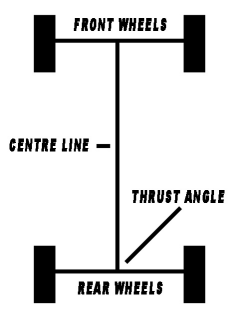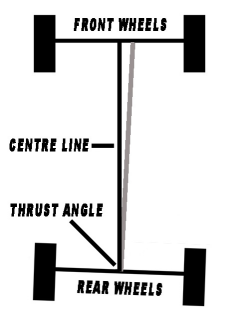Registrations
We now manually approve all new user accounts due to a large influx of spam bots. Accounts are normally approved within 48 hours.
If you need any help with using this Wiki, please ask here: TalkFord.com Wiki Submission Forum
Tracking vs Geometry
|
Overview Guide | |
| Ford Model: | All |
|---|---|
| Petrol/Diesel: | ??? |
| Estimated Cost: | ??? |
| Difficulty? | ??? |
| How long does this take? | ??? |
Tracking vs Geometry – An explanation
There seems to be some confusion as to whether tracking is a good thing or not when it comes to having your car alignment checked. The short answer is no, tracking does not provide any benefits and can actually make the car handle worse or increase tyre wear compared to before. The following will explain why tracking does not work and geometry does.
Tracking is where the front wheels are checked against each other using a laser and then moved until the beam is a mirror of itself on the opposite wheel. However, you need to ask yourself this question, what are the wheels actually being aligned to? The answer is not each other, in fact they are not being aligned to anything using tracking…you will find out shortly what they need aligning to.
The gauges may show the wheels as being out of alignment; however, what they do not show is which one(s) will need adjusting. Therefore the work is done blind, so you could end up with front wheels looking like the following // \\ and even if they do look like this | | there is no way of knowing what the actual angles measure. You can guarantee the wheels will not be accurately aligned because as stated previously they have not been aligned to anything. So to answer the question; what do the wheels align to? The answer is the rear thrust angle; which is the centre point of the vehicles chassis and should always be as close to zero degrees as possible. There is an imaginary line joining both the front and rear wheels together and then a line joining these down the centre. Where the centre line meets the line joining the rear wheels this is the thrust angle and it shows where all four wheels sit in relation to each other.
When a vehicle is measured on a geometry machine each wheel can be independently aligned to the thrust angle with the help of viewing the angles on a computer screen. This is done via separate panels being positioned on each wheel, which are then linked to the computer via lasers. It does not matter if the car only has adjustable front/rear toe, camber, caster or all three. If the rear suspension is adjustable in some form, then a geometry is a must, nothing else will suffice.
If the rear is not adjustable or there are no complaints regarding handling and tyre wear on an adjustable rear, then a four wheel alignment can be done as an absolute minimum, although risky. This is where the front wheels are aligned to the rear regardless of what angles they are currently set to. If the rear wheels are not aligned correctly, whether it is fixed or adjustable suspension, the front wheels will not be accurate. This is the beauty of a geometry, all angles can be measured regardless of what is adjustable or not so this will show any abnormalities such as a bent suspension component or the cause of uneven tyre wear, such as too much negative camber from a broken coil or worn bushes.
The image below shows an example of the rear wheels not being aligned at the correct angles. If this was a four wheel alignment the front wheels would be measured against the rear. Therefore, they would be incorrectly aligned to the grey line rather than the black. This would cause the vehicle to pull as it would use the grey line as its centre and also cause uneven tyre wear. So if the rear had a bent suspension component or the angles are wrong to start with, this would compromise the thrust angle, therefore, the front wheels would be aligned incorrectly.
A geometry check should be carried out whenever the suspension has had work done. It does not matter whether you take the whole suspension out or just change a track rod end. Just undoing a few bolts can change your cars geometry, handling and tyre wear.
Yes a geometry will cost more than tracking and not much more than four wheel alignment. However, in the long run it will be cheaper than having to keep getting the tracking redone because the car does not ‘feel right’ afterwards, plus there is also the cost of replacing unevenly worn tyres. Unfortunately the majority of the public and industry are uneducated about the realms of chassis alignment and many garages simply can’t afford to invest in state of the art equipment, therefore they stick to the tracking method!
If a job is worth doing it is worth doing once and correctly. Hopefully this has helped you understand the differences between tracking and geometry.
- Capri Mk1
- Capri Mk2
- Capri Mk3
- Cortina Mk1
- Cortina Mk2
- Cortina Mk3
- Cortina Mk4
- Cortina Mk5
- Cougar Mk1
- C-Max Mk1
- C-Max Mk2
- Escort Mk1
- Escort Mk2
- Escort Mk3
- Escort Mk4
- Escort Mk5
- Escort Mk6
- Fiesta Mk1
- Fiesta Mk2
- Fiesta Mk3
- Fiesta Mk4
- Fiesta Mk5
- Fiesta Mk6
- Fiesta Mk7
- Focus Mk1
- Focus Mk2
- Focus Mk3
- Fusion Mk1
- Galaxy Mk1
- Galaxy Mk2
- Galaxy Mk3
- Granada Mk1
- Granada Mk2
- Granada Mk3
- Ka Mk1
- Ka Mk2
- Kuga Mk1
- Mondeo Mk1
- Mondeo Mk2
- Mondeo Mk3
- Mondeo Mk4
- Puma Mk1
- S-Max Mk1
- Sierra Mk1


 Your Privacy Choices
Your Privacy Choices